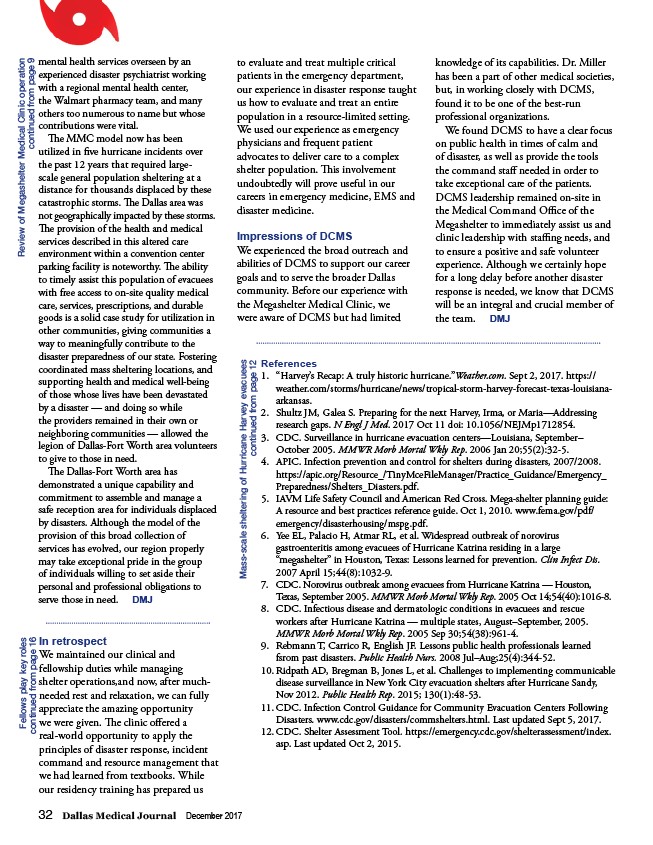
mental health services overseen by an
experienced disaster psychiatrist working
with a regional mental health center,
the Walmart pharmacy team, and many
others too numerous to name but whose
contributions were vital.
Th e MMC model now has been
utilized in fi ve hurricane incidents over
the past 12 years that required largescale
general population sheltering at a
distance for thousands displaced by these
catastrophic storms. Th e Dallas area was
not geographically impacted by these storms.
Th e provision of the health and medical
services described in this altered care
environment within a convention center
parking facility is noteworthy. Th e ability
to timely assist this population of evacuees
with free access to on-site quality medical
care, services, prescriptions, and durable
goods is a solid case study for utilization in
other communities, giving communities a
way to meaningfully contribute to the
disaster preparedness of our state. Fostering
coordinated mass sheltering locations, and
supporting health and medical well-being
of those whose lives have been devastated
by a disaster — and doing so while
the providers remained in their own or
neighboring communities — allowed the
legion of Dallas-Fort Worth area volunteers
to give to those in need.
Th e Dallas-Fort Worth area has
demonstrated a unique capability and
commitment to assemble and manage a
safe reception area for individuals displaced
by disasters. Although the model of the
provision of this broad collection of
services has evolved, our region properly
may take exceptional pride in the group
of individuals willing to set aside their
personal and professional obligations to
serve those in need. DMJ
32 Dallas Medical Journal December 2017
References
1. “Harvey’s Recap: A truly historic hurricane.”Weather.com. Sept 2, 2017. https://
weather.com/storms/hurricane/news/tropical-storm-harvey-forecast-texas-louisianaarkansas.
2. Shultz JM, Galea S. Preparing for the next Harvey, Irma, or Maria—Addressing
research gaps. N Engl J Med. 2017 Oct 11 doi: 10.1056/NEJMp1712854.
3. CDC. Surveillance in hurricane evacuation centers—Louisiana, September–
October 2005. MMWR Morb Mortal Wkly Rep. 2006 Jan 20;55(2):32-5.
4. APIC. Infection prevention and control for shelters during disasters, 2007/2008.
https://apic.org/Resource_/TinyMceFileManager/Practice_Guidance/Emergency_
Preparedness/Shelters_Diasters.pdf.
5. IAVM Life Safety Council and American Red Cross. Mega-shelter planning guide:
A resource and best practices reference guide. Oct 1, 2010. www.fema.gov/pdf/
emergency/disasterhousing/mspg.pdf.
6. Yee EL, Palacio H, Atmar RL, et al. Widespread outbreak of norovirus
gastroenteritis among evacuees of Hurricane Katrina residing in a large
“megashelter” in Houston, Texas: Lessons learned for prevention. Clin Infect Dis.
2007 April 15;44(8):1032-9.
7. CDC. Norovirus outbreak among evacuees from Hurricane Katrina — Houston,
Texas, September 2005. MMWR Morb Mortal Wkly Rep. 2005 Oct 14;54(40):1016-8.
8. CDC. Infectious disease and dermatologic conditions in evacuees and rescue
workers after Hurricane Katrina — multiple states, August–September, 2005.
MMWR Morb Mortal Wkly Rep. 2005 Sep 30;54(38):961-4.
9. Rebmann T, Carrico R, English JF. Lessons public health professionals learned
fsrom past disasters. Public Health Nurs. 2008 Jul–Aug;25(4):344-52.
10. Ridpath AD, Bregman B, Jones L, et al. Challenges to implementing communicable
disease surveillance in New York City evacuation shelters after Hurricane Sandy,
Nov 2012. Public Health Rep. 2015; 130(1):48-53.
11. CDC. Infection Control Guidance for Community Evacuation Centers Following
Disasters. www.cdc.gov/disasters/commshelters.html. Last updated Sept 5, 2017.
12. CDC. Shelter Assessment Tool. https://emergency.cdc.gov/shelterassessment/index.
asp. Last updated Oct 2, 2015.
In retrospect
We maintained our clinical and
fellowship duties while managing
shelter operations,and now, after muchneeded
rest and relaxation, we can fully
appreciate the amazing opportunity
we were given. Th e clinic off ered a
real-world opportunity to apply the
principles of disaster response, incident
command and resource management that
we had learned from textbooks. While
our residency training has prepared us
to evaluate and treat multiple critical
patients in the emergency department,
our experience in disaster response taught
us how to evaluate and treat an entire
population in a resource-limited setting.
We used our experience as emergency
physicians and frequent patient
advocates to deliver care to a complex
shelter population. Th is involvement
undoubtedly will prove useful in our
careers in emergency medicine, EMS and
disaster medicine.
Impressions of DCMS
We experienced the broad outreach and
abilities of DCMS to support our career
goals and to serve the broader Dallas
community. Before our experience with
the Megashelter Medical Clinic, we
were aware of DCMS but had limited
knowledge of its capabilities. Dr. Miller
has been a part of other medical societies,
but, in working closely with DCMS,
found it to be one of the best-run
professional organizations.
We found DCMS to have a clear focus
on public health in times of calm and
of disaster, as well as provide the tools
the command staff needed in order to
take exceptional care of the patients.
DCMS leadership remained on-site in
the Medical Command Offi ce of the
Megashelter to immediately assist us and
clinic leadership with staffi ng needs, and
to ensure a positive and safe volunteer
experience. Although we certainly hope
for a long delay before another disaster
response is needed, we know that DCMS
will be an integral and crucial member of
the team. DMJ
continued from page 9
Review of Megashelter Medical Clinic operation
continued from page 12
Mass-scale sheltering of Hurricane Harvey evacuees
Fellows play key roles
continued from page 16